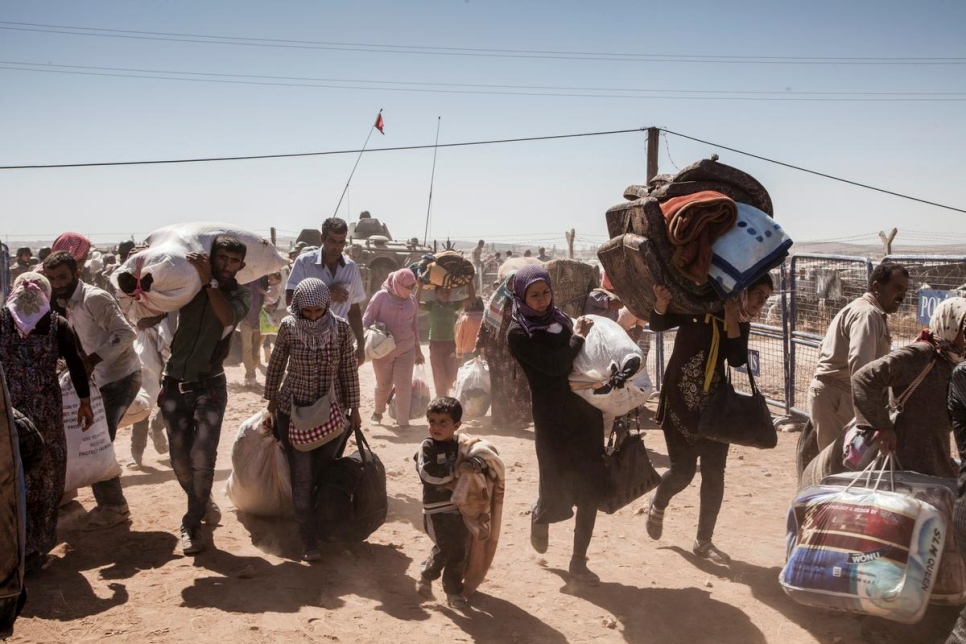The Refugee Convention and Armed Conflict
Introduction
With increasing armed conflicts around the world, the 21st century has seen a massive increase in refugee flows from various States around the world. By the end of 2020, there were 82.4 million people displaced due to conflict, persecution, and human rights violations.1UNHCR, “Global Trends: Forced Displacement in 2020” <https://www.unhcr.org/60b638e37.pdf> accessed 8 February 2023 Refugees are those individuals who escape areas of conflict, or areas where they face persecution, and move to different countries to seek protection. According to the United Nations High Commission for Refugees (UNHCR), there were 26.4 million refugees in 2020, with 68% of this figure coming from five countries – Syria, Venezuela, Afghanistan, South Sudan and Myanmar.2ibid This article will trace the trajectory of displacement due to conflict from a historical perspective. It starts by exploring the definition of the term refugee, how this has changed over time, and the main drivers behind why people leave their homes to seek refuge in another country.
Who is a refugee?
The concept of seeking refuge was first given international acceptance under Article 14 of the Universal Declaration of Human Rights (UDHR). Article 14 recognizes that people have the right to seek asylum in another country if they are facing persecution in their homeland. However, one must note that there is no right to be ‘granted’ asylum – the UDHR limits the right to allowing individuals to seek asylum without imposing an obligation on States to grant asylum to all seekers. Moreover, the UDHR does not create a holistic international legal framework to govern the rights of refugees, as well as the obligations of States pertaining to refugee flows. In 1951, the United Nations Convention Relating to the Status of Refugees (“Refugee Convention”) was promulgated pursuant to United Nations General Assembly resolution 429(V) (1950).3United Nations General Assembly Resolution 429(V)/1950
While the Convention was hailed as a legal breakthrough for the protection of refugee rights, the scope of the Convention remains quite narrow in terms of who it protects. Under the Convention, the term ‘refugee’ is temporally and territorially limited to those who “before 1 January 1951”, [have] been persecuted due to reasons such as race, religion, or nationality, membership of a particular social group or political opinion’.4Article 1(A), UN Refugee Convention 1951 The Convention defines “before 1 January 1951” as events occurring in Europe before 1 January 1951 or events occurring in Europe or elsewhere before 1 January 1951, referring to the Second World War and the refugee flows stemming from it.5Ibid, Article 1(B)(1) While the temporal limit is fixed, it was left up to Contracting States to decide the territorial limit of whether they wanted to include States outside Europe or whether they would limit the definition to just Europe.6Ibid, Article 1(B)(2)
However, this meant that the Refugee Convention adopted a Eurocentric approach, restricting protection to European refugees created by one particular conflict. In 1967, the Protocol Relating to the Status of Refugees extended the protection of the Convention to all refugees, removing the temporal and territorial limit of the Convention’s definition.7Article 1(2), Protocol Relating to the Status of Refugees, 1967 Thus, while the Convention on its own may be seen as narrowly defining protection, the Protocol extends said protection to refugees worldwide created by modern conflicts as well.
As per the UNHCR, the 1951 Convention has 145 States Parties, with the 1967 Protocol having 146 States Parties.8UNHCR ‘States Parties to the 1951 Convention relating to the Status of Refugees and the 1967 Protocol’ https://www.unhcr.org/protect/PROTECTION/3b73b0d63.pdf, accessed 8 February 2023 The Convention and Protocol aim to establish a set of minimum rights that each State Party must guarantee to its refugees. These instruments do not enjoy the unanimous ratification of the international community, compared to other human rights treaties. Notable exclusions include Pakistan, India and Bangladesh, despite the fact that all three States are refugee-hosting nations and are located in a region marked with armed conflict.9ibid The lack of universal ratification of the Refugee Convention and Protocol result in gaps in protection for refugees depending on which States they are from, and which States they travel to.
The Definition’s Omission of Armed Conflict
People often leave their homes as a last resort. The decision to leave one’s home and seek refuge in a foreign country comes due to a variety of social, political and economic factors.10Asia Pacific Refugee Rights Network, Understanding and Addressing Root Causes of Displacement in the Asia-Pacific, 2015. https://reliefweb.int/report/world/understanding-and-addressing-root-causes-displacement-asia-pacific accessed 8 February 2023 The Refugee Convention recognises as refugees those who have a ‘well-founded fear of being persecuted for reasons of race, religion, nationality, membership of a particular social group or political opinion’.11Article 1(A)(2), UN Refugee Convention To afford one protection, there must be a determination of a well-founded fear of persecution for belonging to one of the categories mentioned in the provision. The UNHCR has provided interpretive commentary on this criteria. According to the UNHCR,
The term “well-founded fear” contains a subjective element, represented by the applicant’s state of mind to be assessed mainly by evaluating the applicants’ statements, and an objective element, which is to be assessed on the basis of the situation prevailing in his/her country of origin.12UNHCR ‘Advisory Opinion by the UNHCR on the Interpretation of the Refugee Definition’, https://www.refworld.org/pdfid/4551c0374.pdf accessed 8 February 2023, para 7
Similarly, the term ‘persecution’ refers to serious human rights violations leading to consequences of a substantially prejudicial nature for the person concerned.13Ibid, para 8 Therefore, in order to avail refugee protection, one must show that due to the prevailing situation in his/her country, they have a reasonable apprehension of being subjected to serious human rights violations as a result of their identity.
However, one must note that the Refugee Convention curiously does not recognise ‘escaping armed conflict’ as a legitimate reason to seek refugee status under the definition provided in Article 1(A)(2). This is in contrast to the Convention Governing the Specific Aspects of Refugee Problems in Africa, 1969, which recognises the right to protection as a refugee as a result of ‘external aggression, occupation, foreign domination or events seriously disturbing public order in either part or the whole of his country or origin of nationality.’14Article 1(2), Convention Governing the Specific Aspects of Refugee Problems in Africa 1969 Similarly, the Cartagena Declaration on Refugees extends the definition of ‘refugee’ to:
persons who have fled their country because their lives, safety or freedom have been threatened by generalized violence, foreign aggression, internal conflicts, massive violation or human rights or other circumstances which have seriously disturbed public order.15Conclusion III(3), Cartagena Declaration on Refugees
Thus, these instruments acknowledge the need to escape violence and armed conflict as a legitimate qualification for refugee status. Indeed, the UNHCR recognises escaping violence and armed conflict as part of its mandate as well;16‘UNHCR – What Is a Refugee?’ https://www.unhcr.org/what-is-a-refugee.html accessed 8 February 2023 however, this does not stem from the language of the Convention.
Armed conflict gives rise to refugee flows when a belligerent party fails to observe the rules of international humanitarian law (IHL). A belligerent party to the conflict must observe the principle of distinction, which restricts the belligerent party to only target combatants and military objectives; they are not allowed to target civilians and civilian objects (such as homes and hospitals) in the conduct of hostilities. However, where belligerent parties violate the principle of distinction and launch indiscriminate attacks against the civilian population (such as aerial bombings and the use of indiscriminate weapons, such as landmines), the lives and livelihoods of ordinary citizens become vulnerable. Thus, citizens seek refuge in other countries in order to protect their lives and livelihoods (or whatever little they can protect).
Nevertheless, certain armed conflicts have involved and are characterised by the commission of war crimes, crimes against humanity, and genocide. For example, the Yugoslav War in the early 1990s was marked by the genocide of Bosnian Muslims, with notable events including the Srebrenican massacre. The Yugoslav War resulted in between 3.7 million and 4 million refugees.17‘Where We Work’ (UNHCR South Eastern Europe) https://www.unhcr.org/see/where-we-work accessed 8 February 2023 Similarly, the Myanmar civil war has resulted in the targeted persecution of Rohingya Muslims, with around 980,000 Rohingya Muslims having sought refuge in neighbouring countries.18‘Rohingya Refugee Crisis Explained’ (UN Refugees) https://www.unrefugees.org/news/rohingya-refugee-crisis-explained/#RohingyainBangladesh accessed 8 February 2023 Thus, armed conflict may give rise to political instability and tyrannical leadership, resulting in the targeted persecution of particular groups. In these situations, the Convention’s definition applies appropriately.
However, the high threshold of suffering imposed by the Convention’s definition unreasonably limits the scope of protection it provides. The definition in the Refugee Convention does not adequately extend protection to those that flee their countries fearing violence due to armed conflict who may not necessarily be fearing ‘persecution’ as defined by the UNHCR. The African Convention’s incorporation of this mirrors the reality of modern armed conflict and affords protection to all those who wish to escape violence even if it does not amount to serious violations of human rights. The UN High Commissioner for Refugees also stated that
The refugee definition was meant to have an inclusive meaning rather than a restrictive one, in accordance with the fundamental objective of providing international protection to all who need it. The refugee definition should be applied in a generous manner within the framework of fair and efficient individual refugee status determination procedures.19UN High Commissioner for Refugees (UNHCR), Information Note on Article 1 of the 1951 Convention, 1 March 1995
Thus, while one may note the de facto expansive mandate of the UNHCR in extending protection to refugees created by armed conflict, the Convention’s non-recognition of armed conflict that may not necessarily amount to ‘persecution’ in the strictest sense impairs the international community’s ability to afford a minimum standard of protection to those who need it. It allows room for States to formulate refugee policies that impose stringent conditions upon those seeking protection.
Conclusion
While the UN Refugee Convention is a positive step in affording greater standards of protection for refugees worldwide, the definition contained in Article 1(A)(2) continues to be a point of contention. The limited scope created by its definition may not adequately include those fleeing generalised violence caused by an armed conflict while not fearing targeted persecution. Other international legal instruments have indicated an expansive approach, as has the UNHCR in its operational mandate. In order to reflect what the international community considers to be a ‘refugee’, the Convention’s definition needs to give it legal weightage and legitimacy to more effectively regulate universal minimum standards of refugee protection.
The opinions expressed in the articles on the Diplomacy, Law & Policy (DLP) Forum are those of the authors. They do not purport to reflect the opinions or views of the DLP Forum, its editorial team, or its affiliated organizations. Moreover, the articles are based upon information the authors consider reliable, but neither the DLP Forum nor its affiliates warrant its completeness or accuracy, and it should not be relied upon as such.
The DLP Forum hereby disclaims any and all liability to any party for any direct, indirect, implied, punitive, special, incidental or other consequential damages arising directly or indirectly from any use of its content, which is provided as is, and without warranties.
The articles may contain links to other websites or content belonging to or originating from third parties or links to websites and features in banners or other advertising. Such external links are not investigated, monitored, or checked for accuracy, adequacy, validity, reliability, availability or completeness by us and we do not warrant, endorse, guarantee, or assume responsibility for the accuracy or reliability of this information.

Ibrahim Abro
Mohammad Ibrahim Abro is a fifth year student at Lahore University of Management Sciences, pursuing a degree in law. He has keen interests in International law, Post Conflict Justice and Human Rights law.

